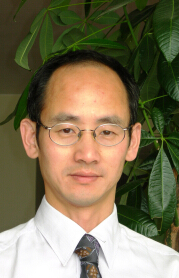讲座题目:Boosting Voltage of Aqueous Flow Batteries with a pH Differential
讲座嘉宾:Prof. Kwong-yu CHAN (The University of Hong Kong)
讲座主持:方岩雄 教授
讲座时间:5月9日(周一)
下午2:30-3:30
讲座地点:广东工业大学工学三号馆-220

嘉宾简介:Kwong-Yu Chanreceived secondary education in Hong Kong and completed a B.Sc. degree in Chemical Engineering atUniversity of Albertain Canada. Before postgraduate studies, he was an assistant lecturer inHong Kong Polytechnicand a project engineer inHong Kong Oxygen & Acetylene Company. He obtained MS and Ph.D. degrees in Chemical Engineering fromCornell University andwas a postdoctoral fellow atCase Western Reserve University.He joined Department of Chemistry atUniversity of Hong Kongin 1988 and is presently a full Professor.
Prof. Chan has research interests inmolecular simulation, fuel cells, batteries, water treatment, materials, and electrochemical applications.He has published over 160 papers on various topics in electrochemistry, physical chemistry, chemical engineering, and materials science, and is a top 1% cited scientist, according to ISI’sEssential Science Indicators. He has been a Regional Editor ofMolecular SimulationandJournal of Experimental Nanoscience.Prof. Chan has six inventions related to fuel cells, ozone generation, batteries, and catalysts. He received theCroucher Foundation Senior Research Fellowship(2010),Universitas 21 Fellowship(2010),Salzburg Global Fellowship(2008), and theHKU Outstanding Researcher(1998, 2012). Dr Chan had held visiting positions atUniversity of UtahandTsinghua Universityand is an honorary Adjunct Professor ofBeijing University of Chemical Technology.
讲座简介:The principle of incorporating electrolytes of differentpHinto a single electrochemical cell to boost cell voltage is discussed via examples of alkaline-acidic hydrogen-oxygen fuel cell[1], metal hydride-lead acid rechargeable battery[2,3], and other electrochemical power sources[4]. The higher voltage and higher energy capacity achieved arise from the additional energy = -79.85 kJ/mol stored/released in the corresponding reaction H++ OH-↔ H2O (DEo=0.828 V). This acid-alkaline neutralization reaction is prevented to take place in the bulk but proceeds as separate half-reactions at positive and negative electrodes, hence termed “electrochemical neutralization”.
The concept ofpHdifferential voltage booster is applied to a vanadium-metal hydride (V-MH) hybrid rechargeable semi-flow battery.[5] Hybridizing the V4+/V5+couple with metal hydride eliminates the problem of V2+oxidation as in vanadium redox flow (VRF) battery. The charge and discharge electrode reactions are as follows:
at the graphite positive electrode: VO2+(aq) + 2H+(aq) + e- ↔ VO2+(aq) + H2O (Eo=1.0 V),
at the metal-hydride negative electrode: MHx+ OH-(aq) ↔ MHx-1+ H2O + e- (Eo= -0.8 V),
and with overall reaction: VO2+(aq)+ 2H+(aq.)+MHx+ OH-(aq) ↔ VO2+(aq)+ MHx-1+2H2O (DEo=1.8 V).
The high voltage (1.8 V) reported is among the highest in the vanadium-based hybrid flow systems, 40% higher than conventional VRF battery (1.4 V) and nickel metal hydride battery (1.2 V). Extension can be made to a vanadium-hydrogen (V-H2) flow battery with theoretical cell voltage of 1.83 V and theoretical energy density of about 300 Wh/kg (which is five times that of a conventional VRF battery).
The two electrolytes are separated by a bipolar membrane, which provides ionic contacts and acts as barrier for proton and hydroxide ions transport in thepHdifferential cell. Improved selectivity in ionic transport is discussed via a new ion-exchange material of polyelectrolyte threaded into a metal organic framework (MOF) [6,7].
Acknowledgements
This research is supported by Innovation Technology Fund of Hong Kong (ITF ITS/290/12), Zentric Inc., Research Grants Council of Hong Kong (GRF HKU 700209P and GRF HKU 700210P), University of Hong Kong SRT on Clean Energy, and The University Development Fund on the Initiative of Clean Energy and Environment.
References
[1] S.A. Cheng and K.Y. Chan*, “High Voltage Dual Electrolyte Electrochemical Power Source”,ECS Trans.25(35) (2010) 213-219.
[2] H. Li, G. Weng, C.Y.V. Li, and K.Y. Chan*, “Three Electrolyte High Voltage Acid-alkaline Hybrid Rechargeable Battery”,Electrochim. Acta, 56(25) (2011) 9420-9425.
[3] G. Weng, C.Y.V. Li*, and K.Y. Chan*, “Lead Acid-NiMH Hybrid Battery System Using Gel Electrolyte”,ECS Trans.41(13) (2012) 133-143.
[4]H. Li, C.Y.V. Li, G.-M.Weng, K.-Y. Chan, “pHDifferential Power Sources with Electrochemical Neutralization” in “Electrochemically Enabled Sustainability” editors: K.Y. Chan and C.Y.V. Li, CRC Press/Taylor & Francis, June 2014.
[5] G. Weng, C.Y.V. Li, and K.Y. Chan, “High Voltage Vanadium-Metal Hydride Rechargeable Semi-Flow Battery”,J. Electrochem. Soc.160(9) (2013) A1384-A1389.
[6] L. Gao, C.Y.V. Li, Kwong-Yu Chan, and Z.N. Chen, "Metal-Organic Framework Threaded with Aminated Polymer Formed in Situ for Fast and Reversible Ion Exchange”, J. Am. Chem. Soc.136 (2014) 7209-7212.
[7] L. Gao, C.Y.V. Li, and K.Y. Chan, "Polystyrene Sulfonate threaded in MIL-101Cr(III): a Cationic Polyelectrolyte Synthesized Directly into a Metal-Organic Framework”,Chem. Mater.27(10) (2015) 3601-3608.